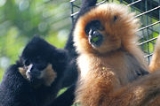
Yellow-cheeked Gibbon
Encyclopedia
The yellow-cheeked gibbon (Nomascus gabriellae), also called the yellow-cheeked crested gibbon, the golden-cheeked crested gibbon or the buffed-cheeked gibbon, is a species of gibbon
native to Vietnam
, Laos
and Cambodia
.
The yellow-cheeked gibbon is born blond and later turns black, and males carry this colouring through their lifespan and have the distinguishing golden cheeks; females are born blonde to blend into their mother's fur but they later turn black and turn back to blond at sexual maturity and only have a black cap on the top of their heads.
This diurnal and arboreal gibbon
lives in primary tropical rainforest, foraging for fruits, using brachiation
to move through the trees.
The yellow-cheeked gibbon, like all gibbon species, has a unique song which is usually initiated by the male. The female will then join in and sing with the male to reinforce their bond and announce to other gibbons that they are a pair in a specific territory. The male usually finishes the song after the female has stopped singing.
Little is known about this species in the wild, but it is thought that it has a life span of approximately 46 years.
A recent report by the Wildlife Conservation Society
counted 2,500 yellow-cheeked crested gibbons in Cambodia’s Seima Biodiversity Conservation Area, an estimate that represents the largest known population of the species in the world.
Gibbon
Gibbons are apes in the family Hylobatidae . The family is divided into four genera based on their diploid chromosome number: Hylobates , Hoolock , Nomascus , and Symphalangus . The extinct Bunopithecus sericus is a gibbon or gibbon-like ape which, until recently, was thought to be closely related...
native to Vietnam
Vietnam
Vietnam – sometimes spelled Viet Nam , officially the Socialist Republic of Vietnam – is the easternmost country on the Indochina Peninsula in Southeast Asia. It is bordered by China to the north, Laos to the northwest, Cambodia to the southwest, and the South China Sea –...
, Laos
Laos
Laos Lao: ສາທາລະນະລັດ ປະຊາທິປະໄຕ ປະຊາຊົນລາວ Sathalanalat Paxathipatai Paxaxon Lao, officially the Lao People's Democratic Republic, is a landlocked country in Southeast Asia, bordered by Burma and China to the northwest, Vietnam to the east, Cambodia to the south and Thailand to the west...
and Cambodia
Cambodia
Cambodia , officially known as the Kingdom of Cambodia, is a country located in the southern portion of the Indochina Peninsula in Southeast Asia...
.
The yellow-cheeked gibbon is born blond and later turns black, and males carry this colouring through their lifespan and have the distinguishing golden cheeks; females are born blonde to blend into their mother's fur but they later turn black and turn back to blond at sexual maturity and only have a black cap on the top of their heads.
This diurnal and arboreal gibbon
Gibbon
Gibbons are apes in the family Hylobatidae . The family is divided into four genera based on their diploid chromosome number: Hylobates , Hoolock , Nomascus , and Symphalangus . The extinct Bunopithecus sericus is a gibbon or gibbon-like ape which, until recently, was thought to be closely related...
lives in primary tropical rainforest, foraging for fruits, using brachiation
Brachiation
Brachiation is a form of arboreal locomotion in which primates swing from tree limb to tree limb using only their arms.- Brachiators :...
to move through the trees.
The yellow-cheeked gibbon, like all gibbon species, has a unique song which is usually initiated by the male. The female will then join in and sing with the male to reinforce their bond and announce to other gibbons that they are a pair in a specific territory. The male usually finishes the song after the female has stopped singing.
Little is known about this species in the wild, but it is thought that it has a life span of approximately 46 years.
A recent report by the Wildlife Conservation Society
Wildlife Conservation Society
The Wildlife Conservation Society based at the Bronx Zoo was founded in 1895 as the New York Zoological Society and currently manages some of wild places around the world, with over 500 field conservation projects in 60 countries, and 200 scientists on staff...
counted 2,500 yellow-cheeked crested gibbons in Cambodia’s Seima Biodiversity Conservation Area, an estimate that represents the largest known population of the species in the world.

